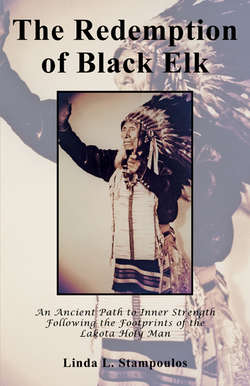Читать книгу The Redemption of Black Elk: An Ancient Path to Inner Strength Following the Footprints of the Lakota Holy Man - Linda L. Stampoulos - Страница 13
На сайте Литреса книга снята с продажи.
ОглавлениеTalking Points:
The Thunder-Beings Speak
Imagine a hot, clear summer day on the Great Plains. Without warning, the sky suddenly darkens, flashes of light strike the tops of the cottonwood trees, setting them ablaze. At the same time sheets of hail, the size of golf balls batter the ground. Fire and ice from the same angry storm. To the Sioux Indians these were Spirit forms, hard to understand yet very powerful. They were wakan. These Thunder-beings who controlled the fire and the ice had both the power to kill and the power to heal. According to Black Elk, from this water all healing herbs grow.
When people of the twenty-first century experience violent storms, one of their first concerns is the interruption of power and the many inconveniences of having to do without electricity for a time. The wonder and magnificence of nature is often lost to the complaint of a “missed” television program or a scramble for candles so often misplaced after the last storm.
The Indians of the Plains, however, lived in a world of nature and experienced its tremendous power all the time. Campbell notes, “just being there, you feel the wonder and you become aware of something larger than the human personification of the energies that exist.”
Black Elk’s experience was not one of peace and soliloquy. As a youth he lived in fear of the Thunder-beings. Continually he would leave his sacred space with a restlessness and passion and return to his people to fulfill the many charges presented him. He would hear the Thunder-beings calling him, but did not know what they wanted. His family watched him hide whenever the storms came, leading them to believe that he had dreamed of thunder.
In Lakota belief, a person who dreams of thunder must perform a ceremony acting out his heyoka dream. The dreamer must obey the command of the Thunder-beings. As part of the obligation, the heyoka ceremony has the dreamer deliberately act like a clown and do things backwards to make people laugh.
The medicine men of his village encouraged Black Elk to enact the horse dance rather than a heyoka ceremony. This performance demonstrated the first part of his great vision. It was after the horse dance that Black Elk said “After this ceremony was completed, it seemed that I was happy to see my people and they looked renewed and happy. I was now recognized as a medicine man at age seventeen. Everyone had respect for me. The fear that I had had now all disappeared and when the Thunder-beings came I was always glad to see them come, as they came as relatives.
The security of a sacred place can be comforting. It serves as a warm retreat from the often harsh realities of our world. It is important to remember, though, that one MUST venture out into the world again as Black Elk did, to meet today’s challenges. One could think of it as temporary oasis, giving us the opportunity for reflection and renewal as we make our life journey.
Throughout his interviews with John Neihardt, Black Elk would reference the symbols and metaphors given to him in his vision, some more powerful than others. We continue our journey with perhaps the most powerful and most referenced in all his teachings, the Sacred Hoop.
